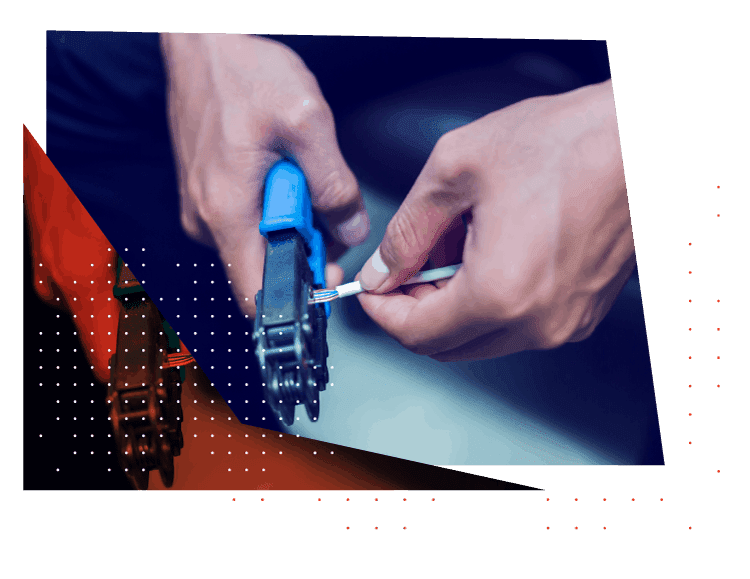13 May Structured Cabling Design and Installation
Structured Cabling Design and Installation
What is structured cabling?
As the blood vessels in our body, a structured cabling system is an intricate network of wiring that transmits data such as multimedia, voice, security, VoIP, and other data throughout a structure like schools or offices. Included in a structured cabling system is anything related to carrying data: hardware, equipment, cables, and jacks.
It’s essential to have well-designed structured cabling. The success of your business or establishment depends on it. A well-designed structured cabling system ensures that all data and resources are transmitted in a timely and efficient manner, reaching the proper venues without hassles.





The Structured Cabling System consists of:
- Horizontal Cabling – it includes everything from the telecommunications room to the outlets in the work area. The cable runs parallel along with the ceiling or floor from the telecommunications room, which may or may not be on the same level.
- Backbone Cabling – it connects all the horizontal cabling within a building or between buildings.
- Telecommunications Room – this room houses the equipment used to tie all the horizontal and backbone cabling. Every structure must have at least one telecommunications room, preferably on the same floor.
- Work Area – it’s comprised of any element from the telecommunications room to the computers in the workstation. It includes outlets, faceplates, wall plates, patch cables, adapters and jacks, and equipment like personal computers, telephones, printers, and scanners.
- Equipment Room – this room houses the telecommunications systems, like servers, routers, switches, PBX’s, and other electronic components. This room is more complicated than the telecommunications room.
- Entrance Facility – this is the junction where the structure’s backbone cabling meets with the outdoor cable. The Entrance Facility is the point where the service provider meets the system of the owner.
The Structured Cabling System consists of:
- Horizontal Cabling – it includes everything from the telecommunications room to the outlets in the work area. The cable runs parallel along with the ceiling or floor from the telecommunications room, which may or may not be on the same level.
- Backbone Cabling – it connects all the horizontal cabling within a building or between buildings.
- Telecommunications Room – this room houses the equipment used to tie all the horizontal and backbone cabling. Every structure must have at least one telecommunications room, preferably on the same floor.
- Work Area – it’s comprised of any element from the telecommunications room to the computers in the workstation. It includes outlets, faceplates, wall plates, patch cables, adapters and jacks, and equipment like personal computers, telephones, printers, and scanners.
- Equipment Room – this room houses the telecommunications systems, like servers, routers, switches, PBX’s, and other electronic components. This room is more complicated than the telecommunications room.
- Entrance Facility – this is the junction where the structure’s backbone cabling meets with the outdoor cable. The Entrance Facility is the point where the service provider meets the system of the owner.



Each of these six components must meet specific standards for the structured cable system to function correctly. Aside from that, the floor plan must be well-designed for maximum efficiency. The proper materials, especially cables and other hardware, must be used so that the system can run for years.
But aside from having quality equipment and cables, the structured cable system must be installed correctly; otherwise, you would have wasted your entire investment. Here are some of the practices involved in the installation:
- Cable Pair Twist – This guideline is the most integral part of the structured cabling installation. Once you lose the twists, you lose efficiency.
- Bend Radius – The following bend radii are under no-load conditions:
- UHP Horizontal – four times the cable diameter
- ScTP Horizontal – eight times the cable diameter
- Multipair backbone – ten times the cable diameter
- 2- and 4-fiber horizontal – Not less than 25mm
- Fiber backbone- Not less than ten times the cable diameter





- Tension – Just the proper amount of tension for maximum efficiency.
- UTP – Pulling tension should not be more than 110N (25lbs/ft). Too much tension leads to the untwisting of paired cables.
- 2- and 4-fiber horizontal – Maximum of 222N (50lbs/ft).
- Cinching – Do not cinch cables too tight; it causes stress and decreases efficiency. Tie the cables loosely and do not staple them.
- Connecting Hardware –
- Twisted pair – Use the same category or higher category of connecting hardware, for example, use CAT6 connectors for CAT6 cables.
- Fiber – Use pre-polished connectors.
The longevity of your structured cables depends on how well-designed the layout is. Correct installation procedures are also to ensure that your system will last from 15-20 years, thus improving the way you run your business.
- Tension – Just the proper amount of tension for maximum efficiency.
- UTP – Pulling tension should not be more than 110N (25lbs/ft). Too much tension leads to the untwisting of paired cables.
- 2- and 4-fiber horizontal – Maximum of 222N (50lbs/ft).
- Cinching – Do not cinch cables too tight; it causes stress and decreases efficiency. Tie the cables loosely and do not staple them.
- Connecting Hardware –
- Twisted pair – Use the same category or higher category of connecting hardware, for example, use CAT6 connectors for CAT6 cables.
- Fiber – Use pre-polished connectors.
The longevity of your structured cables depends on how well-designed the layout is. Correct installation procedures are also to ensure that your system will last from 15-20 years, thus improving the way you run your business.
Source: http://www.blackbox.com/resource/genPDF/Buyers-Guides/Black_Box_Cabling_Guide.pdf






